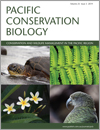
Pacific Conservation Biology
Volume 25 Number 3 2019
The secretive heath skink Liopholis multiscutata is a habitat specialist that in Victoria is restricted to four small disjunct populations in mallee dunefields. This obligate burrower is declining in Victoria and vulnerable to extinction, primarily due to fire and predation. We summarise the ecology and population status of this lizard and provide recommendations for its management.
PC18024The threats to Australia’s imperilled species and implications for a national conservation response
 , Josie Carwardine, April E. Reside, Diana O. Fisher, Martine Maron, Tim S. Doherty, Sarah Legge
, Josie Carwardine, April E. Reside, Diana O. Fisher, Martine Maron, Tim S. Doherty, Sarah Legge  , Jennifer Silcock, John C. Z. Woinarski, Stephen T. Garnett, Brendan A. Wintle and James E. M. Watson
, Jennifer Silcock, John C. Z. Woinarski, Stephen T. Garnett, Brendan A. Wintle and James E. M. Watson
Hundreds of Australian species have experienced significant declines since European occupation and are threatened with extinction. In reviewing the threats affecting these species, we find that invasive species, ecosystem modifications (e.g. fire) and agriculture are most prevalent. We argue that an improved national approach is needed to mitigate these threats.
PC18024 Abstract | PC18024 Full Text | PC18024PDF (791 KB) | PC18024Corrigendum (791 KB) | PC18024Supplementary Material (277 KB) Open Access Article
PC18031‘The dingo menace’: an historic survey on graziers’ management of an Australian carnivore
In the 1950s, a nation-wide survey was conducted to document graziers’ knowledge of, and interactions with, dingoes. Trends in management used to protect livestock were evident, but perceptions of, and experiences with, dingoes were diverse. We discuss how historical context influenced management and how this is important today.
A survey of pest animal trappers revealed that wild dogs have become the main target species for trappers in Australia. The survey provides an overview of trapper practices and behaviours and provides valuable knowledge for developing best-practice guidelines to optimise efficacy and maximise humane treatment of captured animals.
PC18038An ethnobotanical study of traditional steam-bathing by the Batak people of North Sumatra, Indonesia
Steam-bathing is a traditional practice of the Batak people of northern Sumatra for reducing mortality and restoring the health of women after childbirth. This study aimed to document (1) local knowledge of the use of medicinal plants for steam-bathing, (2) preparation and operation of steam-bathing, and (3) benefits of steam-bathing, by surveying traders, midwives and mothers in two traditional markets and two villages. In total, 59 plant species are used as steam-bathing materials by the Batak people; these plants contain essential oils that are volatile when heated, producing their beneficial effects.
Poor quality in freshwater environments inhabited by the Australian lungfish, Neoceratodus forsteri, are threatening the survival of the species. Creation of water impoundments in rivers, with fluctuating water levels, means that food animals for adults and young lungfish are missing, and this effect is made worse by recent droughts and floods. Adults cannot lay eggs with suitable nutrients to permit normal development of young lungfish.
The little fire ant, one of the worst invasive exotic species of the world, is currently spreading into the Pacific. Under pressure from these ants, the invertebrate diversity is reduced to one-third of that in uninfested sites in two studied ecosystems of Tahiti. Some of the birds also seem to be leaving the infested areas.
Incorporating the attitudes, tolerance, and willingness of stakeholders to coexist with wildlife is fundamental to developing successful approaches to the management of human–wildlife conflict. Here, we provide a unique insight into the attitudes of employees living and working in a remote Australian mining township, to the presence of dingoes.
A thermal stress that started in 2002 and peaked at 21 degree heating weeks resulted in near-100% mortality of corals in Kanton Lagoon. An expedition in 2015 documented a 52.8% recovery of hard corals in the lagoon. Despite temperatures reaching as high as 30.5°C there was almost no bleaching of Acropora stands within the lagoon, suggesting that recovering species are more resistant to thermal stress.
We report the first record of a dugong (Dugong dugon Müller, 1776) in Fiji. The dugong, probably a vagrant, was found dead on 20 May 2018 at more than 600 km from the nearest known dugong population, which is in Vanuatu. The dugong, a 2-m-long female, was 13 years old.
PCv25_BR4A Bat's End: The Christmas Island Pipistrelle and Extinction in Australia
PC18024_COCorrigendum to: The threats to Australia’s imperilled species and implications for a national conservation response
PC18024_CO Abstract | PC18024_COCorrigendum (791 KB) Open Access Article



